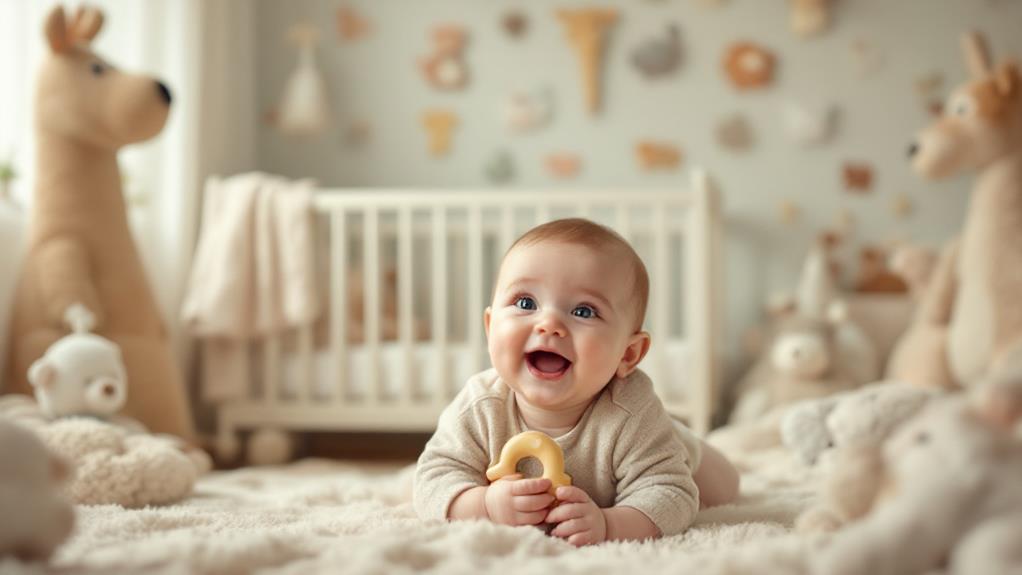How Long Do Babies Teething Last
Teething can feel like an endless saga for you and your baby, usually starting around 6 months and lasting until they’re about 2 to 3 years old. Each new tooth might make its grand entrance over several days or even weeks, so be prepared for some ups and downs. While most babies will have their 20 primary teeth by age 3, the timeline may vary, and that’s perfectly normal! Some babies sail through teething, while others might need extra comfort during this phase. Want to know how to soothe their little gums? Keep exploring; there’s more to discover!
Teething Timeline Overview
When it comes to teething, understanding the timeline can help you prepare for what’s ahead. Teething isn’t just a phase; it’s an adventure! Typically, you can expect your baby to start teething around six months old, but every little one is different. Some might surprise you by showing those tiny pearly whites earlier, while others may take their sweet time.
As the months roll on, those little teeth will march in, usually starting with the front ones. You might notice your baby drooling more, fussing a bit, or even wanting to chew on everything in sight. Don’t worry; it’s all part of the fun!
By the time they’re about three years old, most children will have a full set of 20 primary teeth.
Keep in mind, teething can be a bit of a rollercoaster ride. Some days will be smooth sailing, while others might feel like a stormy sea. You might want to keep a teething ring or a cold washcloth handy to soothe their gums.
Just remember, you’re not alone in this journey—many parents share the ups and downs of teething!
Typical Age Range
Teething usually begins between 4 to 7 months of age, but there’s a wide range of normal. Some babies might start teething a bit earlier or later. It’s all part of their unique journey!
Here’s what to expect:
- Most infants get their first tooth around 6 months.
- Some babies mightn’t show any signs until they’re closer to a year old.
- The bottom front teeth are often the first to pop through, followed by the top ones.
- By the time your little one is around 3 years old, they’ll usually have a full set of 20 baby teeth.
Every baby’s teething timeline is different, and that’s perfectly okay!
You might find that your neighbor’s baby is already sporting a shiny new tooth while yours is still toothless. Remember, it’s a natural process that can take some time.
So, don’t stress too much! Just keep an eye out for those little pearly whites making their grand entrance.
Enjoy this precious phase, even if it comes with some fussiness. It won’t last forever, and before you know it, they’ll be showing off those adorable smiles!
Signs of Teething
Recognizing the signs of teething can help you support your little one through this uncomfortable phase. You might notice that your baby’s gums are swollen or tender, making them fussy or irritable. It’s like having a tiny rock star who’s just a little too cranky to perform!
They may also drool more than usual, leaving you with a collection of bibs that could rival a fashion show.
Another sign to watch for is that your baby may chew on anything they can get their hands on. From toys to your fingers, they’ll find a way to get that pressure relief.
You might also see changes in their eating or sleeping habits. If they suddenly refuse to eat or wake up more often at night, it could be teething-related.
Some babies even develop a slight fever or a rash on their cheeks, but don’t worry too much! Just keep an eye on those symptoms.
If you’re unsure or if things seem extreme, it’s always a good idea to check in with your pediatrician. Remember, you’re not alone on this journey; every parent has been there!
Duration of Teething Phases
As your baby begins the teething journey, it can feel like a marathon rather than a sprint.
Teething lasts a while, and you might find yourself in for the long haul. Generally, the entire process can take anywhere from six months to a couple of years, but the most intense phases usually occur between six months and two years old.
Here’s what you can expect during teething:
-
First Teeth: The first tooth often pops up around six months.
-
Continuous Process: Your little one will keep getting new teeth until about three years old.
-
Phases of Discomfort: Some teeth may come in quickly, while others can cause more fussiness.
-
Relief: Thankfully, once all those teeth are in, you’ll both get a break!
Variability in Teething
Every baby experiences teething differently, which means there’s no one-size-fits-all timeline. Some little ones might start sprouting their first teeth as early as four months, while others may not get their first tooth until they’re closer to a year.
You might find yourself in a teething race with your neighbor’s baby, and that’s perfectly normal!
The order in which teeth come in can vary too. Generally, the two bottom front teeth pop up first, followed by the top front ones.
But don’t be surprised if your baby decides to mix things up a bit. It’s like they’re playing a game of dental roulette!
The intensity of teething symptoms also varies. Some babies might drool like a leaky faucet and fuss a lot, while others might seem completely unfazed.
That’s just how unique your baby is!
Soothe Teething Discomfort
Teething can be uncomfortable for your little one, but there are several effective ways to help soothe their discomfort.
You don’t have to be a superhero to tackle this challenge. With a few simple tricks, you can make your baby feel a lot better!
-
Teething toys: Grab some safe, soft toys for them to chew on. These can help massage their gums and provide relief.
-
Cold compresses: A chilled washcloth or a frozen teething ring can work wonders. The coolness numbs the pain and feels great on sore gums.
-
Gentle gum massage: Use a clean finger to gently massage your baby’s gums. It’s like a mini spa day for their mouth!
-
Distraction: Sometimes, a little distraction goes a long way. Sing a silly song or play their favorite game to take their mind off the discomfort.
When to Seek Help
Sometimes, it can be tough to know when teething discomfort is more than just a normal phase. You might wonder, “Is my baby just fussy, or is there something else going on?”
If your little one seems to be in constant pain, or if you notice unusual symptoms, it’s time to seek help.
Watch for signs like high fever, diarrhea, or rash. If your baby’s temperature rises above 100.4°F (38°C), it could signal an illness rather than teething.
Also, if your baby isn’t eating or drinking well, or if they’re crying inconsolably, don’t hesitate to reach out to your pediatrician.
You know your baby best. If something feels off, trust your instincts!
Sometimes teething can bring on issues that need a professional’s eye. It’s better to be safe than sorry.
Myths About Teething
When it comes to teething, plenty of myths can cloud your understanding. You might hear lots of things that just aren’t true! Let’s clear up some of the most common misconceptions:
- Teething causes fever.
- Babies can’t eat solid food while teething.
- All babies experience teething pain the same way.
- Teething leads to diarrhea.
Many parents believe that teething can trigger a fever, but it usually doesn’t raise your baby’s temperature much. A slight increase is normal, but anything above 100.4°F might be something else entirely.
Also, don’t worry if your little one is gnawing on their favorite teething toy; they can still enjoy solid foods!
Every baby is unique, so their teething experience can vary. Some might fuss a little, while others handle it like champs.
Finally, while teething can lead to a messy diaper situation, it’s not a direct cause of diarrhea. So, the next time someone shares a teething myth, feel free to smile and gently set the record straight!
After all, knowledge is power, especially when it comes to your baby’s comfort.
Teething and Sleep Issues
As your baby maneuvers through the teething process, sleep disturbances often arise, leaving both you and your little one feeling restless. Teething can cause discomfort, making it tough for babies to settle down at night. You might notice your baby waking more frequently, fussing, or even crying out. It’s like a nighttime party you didn’t plan for!
To help ease these sleep issues, consider establishing a calming bedtime routine. A warm bath, gentle rocking, or reading a soft story can make a big difference.
Also, try teething toys or a cold washcloth for your baby to chew on before bedtime. The cooler temperature can soothe sore gums and help them feel more comfortable.
Don’t forget about your own sleep! If your baby’s restless nights are taking a toll on you, share the nighttime duties with your partner or take turns caring for your little one.
Remember, this phase won’t last forever. Before you know it, those tiny teeth will be in, and your baby will be back to their normal sleeping habits.




